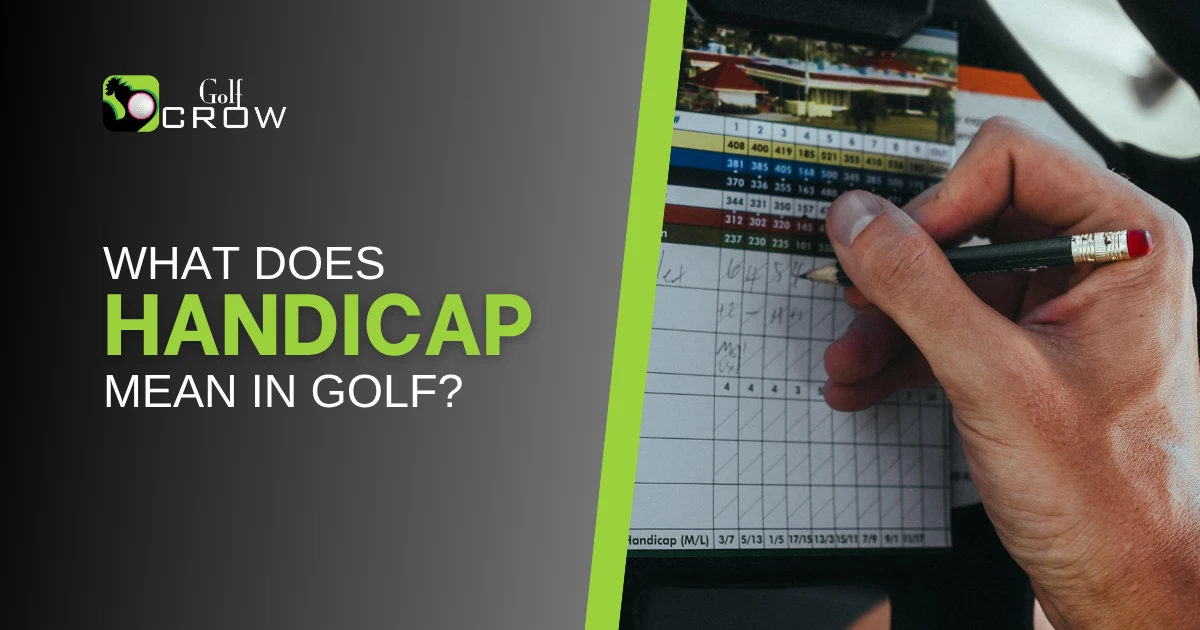Ever hear golfers talk about their “handicap” and feel a little lost? You’re not alone! The term isn’t some secret code or disadvantage; it’s actually golf’s established way of making the game fair for everyone. Read on to understand what does handicap mean in golf and why it’s essential for competitive play. Whether you’re new to the greens or just want to finally get it, this guide is for you.
What Does Handicap Mean in Golf?
Golf is a sport of precision, patience, and often, a touch of personal triumph (or despair). What distinguishes it among competitive sports is its unique fairness system, which gives players at different levels a framework to compete against one another on an equal footing. At the heart of this system lies the concept of a “handicap.” It’s like a basketball game where one side starts with a point advantage in a game to 10. The worse the player the more points they’d start out with. In golf the points appear in the form of strokes given by a Course Handicap.
Simply put, a golf handicap is a numerical measure of a golfer’s skill. The lower your handicap, the better your golfing ability. Think of it as a personalized “head start” or “allowance” that levels the playing field, essentially getting you back to par, the score an expert golfer expects to shoot.
Still a bit hazy? Let’s break it down further.
Why Do We Even Need a Handicap in Golf?
Imagine a scenario where Tiger Woods, arguably the greatest golfer of all time, plays a match against a beginner. Without adjustments, the beginner would be hopelessly outclassed, making the game pointless for both parties. This is where the handicap comes in, it’s designed to make the proper adjustment across players, courses and even conditions.
The primary benefits of a golf handicap are to:
- Promote fair competition: Golfers of varying skill level can compete against each other fairly, whether in friendly matches or structured tournaments. A high handicapper can challenge a low handicapper, and both have a legitimate chance of winning
- Track personal improvement: Your handicap is a dynamic number. As your golf game improves, your handicap will decrease, serving as a tangible measure of your progress. It can of course go in the other direction if your game happens to gets worse
- Encourage participation: Knowing that you can compete and have fun even if you’re not a professional encourages more people to pick up a club and enjoy the game
- Standardize scoring: It provides a consistent method for comparing golfers’ abilities across different courses and conditions
Without the handicap system, golf competition would basically be restricted to professional tours and top amateurs, excluding the vast majority of recreational players. It’s truly the great equalizer of the golf world.
How Does the Golf Handicap System Work? (The Not-So-Secret Formula)
Okay, so you understand why we have handicaps. Now, let’s dive into the process of how a handicap is calculated and used.
Key Terms:
- Handicap Index – this is the number you start out with, as calculated by the golf association in your area following guidelines established by the World Handicap System (WHS). Introduced in 2020, it’s the global standard for calculating handicaps and it provides a portable measure of your ability. To get a golf handicap you need to join a golf club and post a few scores. The system then generates a Handicap Index which becomes your personal input in determining a Course Handicap at whichever course and set of tees you play from. Over time, it resets based on your 8 best scores out of the last 20 rounds
- Course Handicap – this is the actual number of strokes you receive for a particular course and set of tees. You can think of Course Handicap as the number that gets your score back to par. It’s derived by taking your Handicap Index and adjusting it based on the Slope Rating, Course Rating and Par value of the tees you’re playing. It might sound complicated but there are multiple calculators available so you don’t have to do the math yourself.
To distinguish between the two note that Handicap Index is formatted to one decimal place e.g. 8.9, 10.0 and Course Handicap is always rounded to a straight integer number like 8 or 11.
The Formula:
Your Handicap Index gets adjusted by course specific values to get your Course Handicap
Understanding Course Rating, Slope Rating and Par (The Course’s “Difficulty Factors”)
These parameters are necessary because all golf courses are different. Some are long, notoriously hard, with narrow fairways, elevation changes, numerous bunkers, and challenging greens, while others are more forgiving.
- Course Rating: This represents the playing difficulty of a course/tee for a scratch golfer (a golfer with a handicap of 0). It’s the average score a scratch golfer is expected to shoot on that course (basically around par) under normal conditions. It’s expressed in strokes and includes a decimal e.g. 72.5
- Slope Rating: The Slope Rating indicates the relative difficulty of a course for a “bogey golfer” (a golfer with a handicap of around 20-24) compared to a scratch golfer. The higher the Slope Rating, the more difficult the course is for a bogey golfer relative to a scratch golfer. Slope Ratings range from 55 to 155, with 113 considered average
- Par: Usually around 72 for 18 holes or 36 for 9 holes in some combination of par 3, par 4 and par 5 holes e.g. 4 par 3s, 12 par 4s, and 4 par 5s sums to a par of 72
The Relationship: A course with a high Course Rating and a high Slope Rating is generally a very challenging course for all golfers, but especially so for higher handicappers.
What Percentage of Golfers are Good?
The chart below shows how Handicap Indexes are distributed for male golfers in the U.S. As you can see, only a handful shoot par or better consistently. The rest of us mostly live in bogey land or worse.
How is Course Handicap Used in a Round? Gross Score vs Net Score
This is where the rubber meets the road. Once you have a Course Handicap for a round, you can use it to determine your net score, something hopefully close to par or better.
- Gross Score: This is your actual score for the round – the total number of strokes you took. Note that gross score is subject to a Max Score value of net double bogey so no more than par + handicap strokes + 2 on any hole. How do you determine handicap strokes? If the ranked Hole Handicap value is lower the your Course Handicap you receive a stroke on that hole
- Net Score: This is your gross score minus your Course Handicap. This is the score that levels the playing field and is often part of a prize category at golf outings
Example:
Let’s say you have a Course Handicap of 18 for the day. You play a round and shoot a gross score of 95.
Your Net Score = 95 (Gross Score) – 18 (Course Handicap) = 77
Now, imagine you’re playing against a friend who is a much better golfer and only has a Course Handicap of 5. Your friend shoots a gross score of 83.
Your Friend’s Net Score = 83 (Gross Score) – 5 (Course Handicap) = 78
In this hypothetical match, your friend (net score of 78) would lose to you (net score of 77), even though your gross score was significantly higher. This demonstrates how the handicap system allows players of different abilities to compete.
Related Blog: How to Allocate Handicap Strokes in Golf
Beyond Stroke Play: Other Ways Handicaps Are Used
While the example above described stroke play (counting every stroke), handicaps are vital in deciding who wins in other game formats:
- Match Play: In match play, where you compete hole by hole, handicaps are used to determine how many strokes a player receives on a specific hole. For example, if you have a 5-stroke disadvantage over your opponent, you’ll receive a stroke on the five hardest holes on the course
- Stableford: This popular format awards points based on your score on each hole relative to par, after applying your handicap. It often encourages more aggressive play and reduces the impact of a single bad hole
- Scramble, Foursomes, Fourballs: Handicaps are adjusted and combined in these team formats to ensure fairness among the teams
Given that there are additional factors in assigning strokes for match play and other formats, we’ll devote a future post to describing them in further detail.
The Benefits of Having an Official Handicap
Beyond allowing you to compete, having an official handicap offers numerous advantages:
- Personal Performance Tracking: It provides a concrete way to measure improvement over time. There’s satisfaction in watching your handicap (hopefully) decrease
- Eligibility for Tournaments: Most amateur tournaments require participants to have an official handicap to ensure fair competition within different flight divisions e.g. A, B, C flights based on handicap range
- Social Engagement: It makes joining golf leagues, casual games, and inter-club competitions more enjoyable. You’ll know where you stand relative to other players
- Benchmarking: It allows you to compare progress with other golfers worldwide, fostering a sense of community
- Integrity of the Game: The WHS, by standardizing the calculation, adds consistency and credibility to results and competitions globally
Common Misconceptions About Handicaps
Let’s clear up a few common misunderstandings:
- “A high handicap means you’re bad at golf.” Not necessarily. It just means you take more strokes than a lower handicapper. Everyone starts somewhere, and a high handicap simply reflects your current skill level. It’s a starting point for improvement
- “My handicap is fixed.” Absolutely not. Your handicap is dynamic and changes as you submit more scores. It’s designed to reflect your current playing ability
- “I should try to inflate my handicap to win.” This is known as “sandbagging” and is highly unethical in golf. It undermines the fairness of the game and is frowned upon by the golfing community. The WHS has measures in place to identify and adjudicate unusual scoring patterns
- “I keep my handicap artificially low.” The opposite of sandbagging, this is known as a “vanity handicap” and is also unfair to you and your playing partners
- “Handicap is just for pros.” Quite the opposite. Handicaps are primarily for amateur and recreational golfers in order to facilitate fair play
Ready to Get Your Own Handicap?
If you play golf regularly and take part in competitive rounds, getting an official handicap is the next logical step. It will unlock a new dimension of enjoyment and provide a pathway for tracking progress.
Getting an official golf handicap is a relatively straightforward process, especially with the WHS. Here’s a general outline:
- Join an Authorized Golf Club or Association: To obtain an official WHS Handicap Index, you need to be a member of a golf club or an authorized golf association (physical or online). These bodies are responsible for administering handicaps and ensuring the integrity of the system
- Submit Qualifying Scores: You’ll need to submit a minimum number of scores from rounds played under the Rules of Golf. The WHS requires three 18-hole rounds, six 9-hole rounds or some combination thereof totaling at least 54 holes to establish an initial Handicap Index
- Post Scores Consistently: After each round, you must accurately submit your score to your golf club or association’s handicap system. This can often be done through a mobile app or online portal. The more scores you submit, the more accurate and reflective your Handicap Index will be
- Allow for Revisions: Your Handicap Index is automatically updated regularly (usually daily or weekly) based on your most recent scores. As you play more and improve (or have an off day) your handicap will adjust accordingly
It’s crucial to post all your scores, both good and bad. This ensures your handicap reflects your true playing ability and maintains the fairness of the system.
Wrapping Up: The Handicap – Golf’s Fair Play Champion
The golf handicap might seem daunting at first glance but at its core it’s the best system we have to ensure that golf remains accessible, competitive, and enjoyable for everyone, regardless of skill level. It transforms golf from a game solely for the elite into a sport where a novice can challenge an expert, thanks to the magic of stroke allowances.
So, the next time you hear someone talk about their handicap, you’ll understand what they mean and appreciate the intricate yet elegant mechanism that truly makes golf the “gentleman’s game”—a fair game for everyone.
Embrace your handicap, use it as a tool for improvement, and most importantly, have fun out there!
Also Read: How to Read a Gold Scorecard
Golf Crow: The Best Golf Scorecard App!
Most golfers who score a round by hand on a physical card wind up leaving it behind or throwing it out. Why waste all that valuable information you just spent an entire round recording? Believe it or not, there’s a wealth of data here that can help improve your game and more importantly, build lasting memories.
Not interested in messing with paper and pencil and prefer the convenience of your phone? If you love golf and are ready to try the best golf scorecard app that simplifies scoring, tracks your matches, and gives insightful stats without the fuss of paper, you should check out Golf Crow. It’s designed to make your on-course experience smoother and more focused on the game itself with the added benefit of a digital record and the ability to compare results with playing partners. It also features a patented slider-based hole score entry system. Give it a try and see how easy golf scoring can be!
References:
- World Handicap System (WHS) Official Website: https://www.whs.com/ (This is the primary source for information on the unified handicap system)
- R&A Rules of Golf (Governing Body): https://www.randa.org/ (The R&A, along with the USGA, governs the Rules of Golf, which underpin the handicap system)
- USGA Handicap Information: https://www.usga.org/handicapping.html (While the WHS is global, the USGA provides detailed explanations and resources for the system, often with clear examples)
- Course Rating and Slope Database: https://ncrdb.usga.org (Rating Lookup from the USGA)



